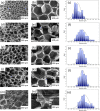Valorization of Agricultural Rice Straw as a Sustainable Feedstock for Rigid Polyurethane/Polyisocyanurate Foam Production
- PMID: 38524426
- PMCID: PMC10956088
- DOI: 10.1021/acsomega.3c09583
Valorization of Agricultural Rice Straw as a Sustainable Feedstock for Rigid Polyurethane/Polyisocyanurate Foam Production
Abstract
Agricultural rice straw (RS), often discarded as waste in farmlands, represents a vast and underutilized resource. This study explores the valorization of RS as a potential feedstock for rigid polyurethane/polyisocyanurate foam (RPUF) production. The process begins with the liquefaction of RS to create an RS-based polyol, which is then used in a modified foam formulation to prepare RPUFs. The resulting RPUF samples were comprehensively characterized according to their physical, mechanical, and thermal properties. The results demonstrated that up to 50% by weight of petroleum-based polyol can be substituted with RS-based polyol to produce a highly functional RPUF. The obtained foams exhibited a notably low apparent density of 18-24 kg/m3, exceptional thermal conductivity ranging from 0.031-0.041 W/m-K, and a high compressive strength exceeding 250 kPa. This study underlines the potential of the undervalued agricultural RS as a green alternative to petroleum-based feedstocks to produce a high-value RPUF. Additionally, the findings contribute to the sustainable utilization of abundant agricultural waste while offering an eco-friendly option for various applications, including construction materials and insulation.
© 2024 The Authors. Published by American Chemical Society.
Conflict of interest statement
The authors declare no competing financial interest.
Figures









References
-
- Singh L.; Brar B. S. A Review on Rice Straw Management Strategies. Nat., Environ. Pollut. Technol. 2021, 20 (4), 1485–1493. 10.46488/NEPT.2021.v20i04.010. - DOI
-
- Gummert M.; Van Hung N.; Chivenge P.; Douthwaite B.; Published online, 2019, pp 1–192.10.1007/978-3-030-32373-8.Sustainable Rice Straw ManagementSustain Rice Straw Manag. - DOI
-
- Moliner C.; Bove D.; Arato E. Co-incineration of rice straw-wood pellets: A sustainable strategy for the valorisation of rice waste. Energies 2020, 13 (21), 5750.10.3390/en13215750. - DOI
-
- Muliarta I. N. A study on rice field farmer implementation of rice straw composting. IOP Conf. Ser.: Earth Environ. Sci. 2019, 343 (1), 012001.10.1088/1755-1315/343/1/012001. - DOI
LinkOut - more resources
Full Text Sources
